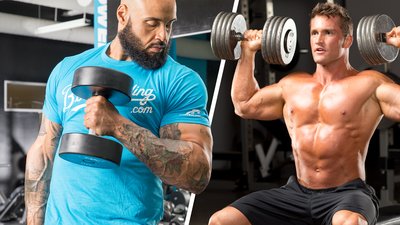Are you pressed for time in the gym, trying to pack in more bang for your buck? Or are you looking to simply get more out of your tried-and-true exercises? In both cases, if you're not, you probably should be.
The answer is to mix up staple movements, and even combine them. I regularly program two types of combination exercises: those in which two or more exercises are blended together into one, and those in which two or more exercises are strung together in a cohesive manner like a mini circuit.
Both types are fantastic for boosting troublesome, lagging muscle groups, boosting coordination along with strength, and creating a huge muscle pump. This is a great way to pack a lot of action into a short amount of time, particularly when it comes to assistance work or prehab.
1. Combo Row
I learned this exercise years ago from trainer Nick Tumminello as a good mix between a horizontal and vertical row. The combo row elicits a great pump in the lats, which will help hardgainers build a thicker, wider back. It also teaches you to tie together the lats and hips, making for a more powerful backside overall.
The key is to get a stretch in the lats, which means aligning the arms with the ears before the start of each repetition.
2. Offset Farmer's Walk with Goblet Squat
Offset means that one dumbbell is at least twice as heavy as the other. This forces the core to work hard to keep you from leaning sideways as you walk. My favorite variation of this is a heavy dumbbell in one hand (such as 100 pounds) and a lighter dumbbell (say, 40-50 pounds) with a Fat Grip on it in the other, as I discussed in my article "The Do's and Don'ts of Fat-Grip Training."
Walk as far as you can with the unequal weights. When you can't hold them any longer, put them down, then pick up the heavy one and perform 10 goblet squats.
When the set of squats is complete, switch hands with the dumbbells, and keep going. This way, your core gets extra work, one hand gets heavy work while the other gets open-hand work, and you get to exhaust your legs while you're resting your tired hands. No rest for the weary!
3. Hammer Curl, Press, Reverse Curl
Grab a pair of dumbbells that will challenge you for a set of 10 biceps curls. Since most people are significantly stronger in a biceps curl than a reverse curl, the eccentric-only reverse curl will be a killer. Just a warning.
Curl the weight using a hammer grip (thumbs up as you curl), then press overhead. Lower back down, then return to the starting position via a reverse curl, taking care to go nice and slow, keeping the elbows close to your sides. Repeat that for 10 reps, and your arms will burn all over, not just in the belly of your biceps.
4. Side Plank With External Rotation
Focusing on the squat, deadlift, and bench press—the big three—is a great goal for those who want to get stronger. But core strength and rotator cuff strength are crucial and often overlooked in training for the powerlifts, and shoulder pain abounds in powerlifters. The side plank with external rotation can help all three lifts. It's great for the obliques and lateral hips, both of which help bolster the squat and deadlift, and the external rotators of the shoulder, which are essential to strengthen when you're benching a lot.
Don't expect to feel strong here, though. You'll be surprised how much harder it is to stabilize while performing external rotations with just a few pounds in each arm. Start with 3-pound dumbbells and go slowly for 10 reps—seriously! In the True Muscle video workout series, Nick Tumminello has NFL veteran Steve Weatherford use no more than 5 pounds—and it's plenty tough. When you've finished your 10, flip to the other side.
5. Inverted Row and Hanging Leg Curl
Inverted rows are great! All you need is a suspension trainer and a chin-up bar, and you can crush your back with endless rowing variations. One of my favorite hamstring exercises, the hanging leg curl, is also easily performed with a suspension trainer. Combining the two is a no-brainer.
Perform one row, then one curl, alternating until the mega-set is complete, usually for 8-12 repetitions. This is not easy!
6. Stability-Ball Pike To Rollout
This is a great combination exercise that targets the upper and lower abs while limiting hip-flexor involvement. Find a stability ball and get in a push-up position while keeping the feet about shoulder-width apart. For beginners, simply staying on the ball is a challenge, so a wide base helps.
The goal is to get the ears in line with the arms on the pike, and then again on the roll-out portion. Be careful to keep the abs very tight so they can protect the lower back. When an athlete runs out of core strength, the lower back will start to sag and excessively arch, which is a big no-no. Keep the core tight and neutral, and stay under control into the rollout portion. Do it right, and this one is an ab killer!
7. Hamstring Triple Threat
The hamstrings cross both the hip and knee joints, and for this reason they perform a myriad of functions in lower-body movements. The big three that we commonly train are straight-legged hip-hinging (think stiff-legged deadlifts), bent-legged hip hinging (good mornings and RDLs) and knee-flexion (hamstring curls). This circuit combines all three, hitting the hamstrings hard.
We use it to prevent hamstring injuries and rehab lower-extremity injuries. You'll feel the hamstrings burn in distinctly different places on each of the three exercises in the circuit. We usually start clients off with 8 reps of all three, and progress them to 12 before adding light weights to the hips. Those Body Bars that are hanging around every gym work perfectly here. If your hamstrings lag behind your quads, this circuit will boost them up in a hurry.
How to Build These into Your Program
Many of these can be substituted right into your program for an existing exercise of the same movement or muscle group. But, my favorite place to put combination exercises is either at the beginning or end of a workout. The biggest strength of combination exercises is that they force more blood into the muscle, causing a tremendous pump and increased metabolic stress. As such, these can fatigue a person surprisingly quickly, even though none of them are heavy or fast.
I suggest using these combinations as a warm-up to pre-exhaust a muscle, giving it extra attention that will help it grow, and forcing it to work harder during the workout. Or, use them at the end as a finisher, to really blast a muscle group at the end when you can go for broke and head home. You can "leave it all out on the field," so to speak.
Either method works great, so experiment a little and see how they can improve your physique and help reach your strength goals, while feeling great doing it.

